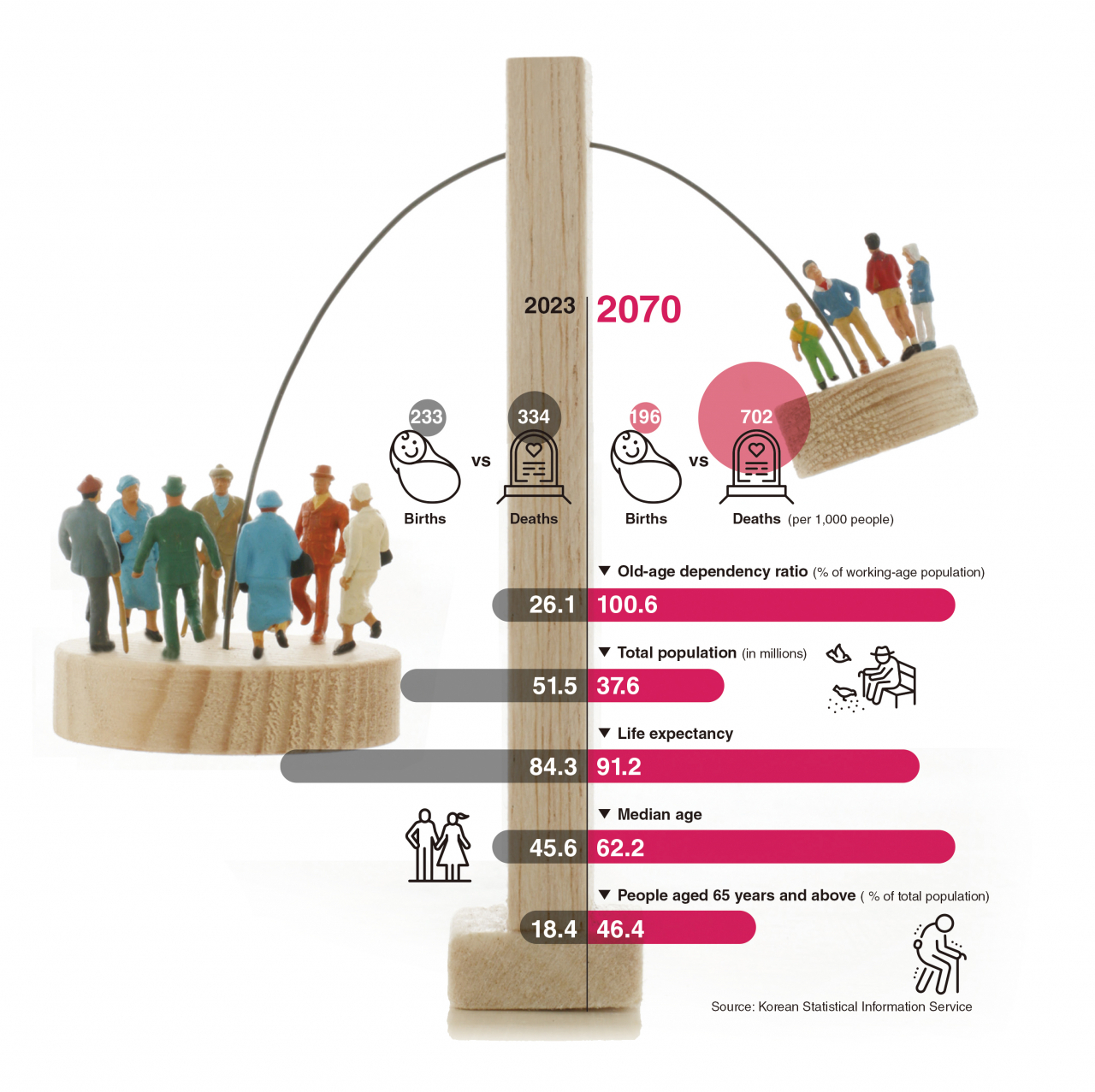 |
Correction: The data on births and deaths should have read "unit: 1000 persons," not "per 1000 people." We regret the error. -- Ed. |
A dynamic, cutthroat society that never rests -- that has been South Korea until now.
Changes have taken place in this Asian country in recent decades at speeds no other nation could follow: from poverty to prosperity, from the ruins of colonial occupation and civil war to becoming a rising cultural superpower on the international stage.
But at the same breakneck pace, Korea is leading the world into a future where the majority live past 90 years old and fewer people are working to keep the economy going.
According to projections by the government-run Korean Statistical Information Service, Korea in 2070 will have a population of 37.6 million, about 27 percent less than today’s. Deaths, at 702,000, will far outweigh births, at 196,000. The median age of the population will be 62.2.
Here’s a glimpse into Korea in 2070 based on the KOSIS data, interpreted by The Korea Herald.
Country for old men
In 2070, Korea’s population will be predominantly elderly.
People aged 65 and above will account for 46.4 percent, becoming the largest demographic group. Currently, this age group takes up 18.4 percent of the population.
What’s more, the share of people aged 85 or older will take up a full 21.8 percent of the total, up from the current 4.5 percent.
Today, the 15-64 age group, which is currently defined as the working-age population, makes up 70.5 percent -- by far the largest portion of the population -- but this group is projected to shrink to below 50 percent -- 46.1 percent to be precise.
A key factor making this situation possible is continued improvement in South Koreans' life expectancy, supported by the country's robust, highly accessible and affordable public healthcare system.
Those born in 2070 will have a life expectancy of 91.2 years, up from the present 84.3 years.
Such a longer life span, coupled with the continually declining number of births, will transform the country’s demographic profile into an inverted pyramid with a larger elderly population and fewer younger people.
The median age of Koreans living in 2070 is projected at 62.2 years, a significant rise from the current 45.6 years, making the country indeed a "land of the old."
More people living alone
Forty-seven years from now, the typical nuclear family of 1990s sitcoms -- a family of four consisting of two heterosexual parents and two children -- will likely be harder to find.
The number of single-person households is projected to hit almost 10 million in 2050, growing from 7.3 million this year. The number of the elderly living alone will rise in tandem. The number of one-person households consisting of those 65 and older is expected to more than double from the current 1.9 million to 4.6 million in 2050.
Although the KOSIS data on single-person households does not provide projections for 2070, it looks likely that a far larger portion of Koreans alive in 2070 will be such loners.
A related trend to watch is that of falling marriages.
Every year, fewer Koreans are tying the knot. Marriages declined 9.8 percent on-year to 192,507 in 2021, Statistics Korea data released last year showed. 2021 marked the lowest number since the government started compiling such data in 1970 and part of a decade-long continuous fall in the number of marriages since 2011. The figure stood at 329,087 in 2011.
Meanwhile, the number of divorces came to 102,000 in 2021. It dropped 4.5 percent on-year, after falling 3.9 percent in 2020 from the previous year. Yet the number had increased in both 2018 and 2019, indicating fluctuations.
With out-of-wedlock births rare here, the declining marriage trend has a significant impact on Korea's total fertility rate. The average number of children that a woman is expected to give birth to over her lifetime plummeted from 1.65 in 1993 to 0.78 in 2022.
More culturally diverse?
The need for the country to reverse its plunging population and counteract its rapid aging presents an existential crisis for Korea. This is why admitting more immigration is being floated as the answer for the survival of this self-proclaimed ethnically homogeneous nation.
The government’s latest data showed that the number of residents of foreign nationality here came to 2.13 million as of November 2021. The figure has declined slightly for two consecutive years.
As for the “multicultural population," which refers to those belonging to families consisting of one parent of Korean citizenship and the other of foreign nationality, and their offspring, if any, the tally stood at 385,219, as of the end of 2021. It jumped from 229,241 in 2015.
The KOSIS projections for 2070 do not cover immigrants or the multicultural population.
Will the inflow of people from overseas be enough to offset the natural decline of Korea's population? Will Korea be a more ethnically diverse country by 2070?
Talk abounds on whether Korea will finally break away from its policy of tight immigration controls and open up to welcome more residents of foreign nationality.
“South Korea’s fast transition into an aging society coupled with its low fertility rates have increased demand for a foreign workforce,” said Lee Kyo-yong, a researcher at the state-affiliated Korea Labor Institute, said in a report published last year. “It needs to strengthen its immigration policy to cater to the needs of immigrants in terms of education and to ease the conditions for staying in this country.”






![[Today’s K-pop] Blackpink’s Jennie, Lisa invited to Coachella as solo acts](http://res.heraldm.com/phpwas/restmb_idxmake.php?idx=644&simg=/content/image/2024/11/21/20241121050099_0.jpg)
